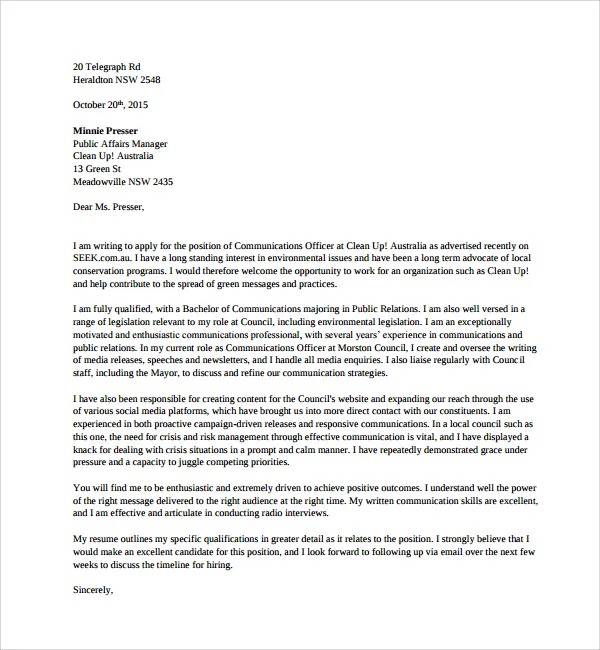Crafting an Irresistible Communication Job Cover Letter
In the competitive world of communication jobs, your cover letter is your first chance to shine. It’s not just a formality; it’s a powerful tool to demonstrate your skills, experience, and passion for the role. A well-crafted cover letter can significantly increase your chances of landing an interview and ultimately securing your dream job. This guide will unlock the secrets to crafting a cover letter that not only gets you noticed but also leaves a lasting impression on potential employers, transforming your application from a simple submission into a compelling pitch. Get ready to learn how to write a cover letter that captivates and convinces.
Highlighting Relevant Skills and Experience
The key to a successful cover letter is relevance. Begin by carefully studying the job description. Identify the specific skills and qualifications the employer is seeking. This is your roadmap. Next, review your resume and pinpoint instances where you’ve demonstrated those skills. Focus on achievements that align with the job requirements. Think of this as a targeted campaign, where every word serves a purpose. Did you manage a successful social media campaign? Did you create engaging content that increased audience engagement? Quantify your successes whenever possible. How much did your efforts increase brand awareness or lead generation? Providing concrete examples and measurable results makes your claims more credible and impactful. Your cover letter is a bridge connecting your past experiences to the opportunity at hand; ensure the connection is clear and compelling.
Showcasing Communication Skills
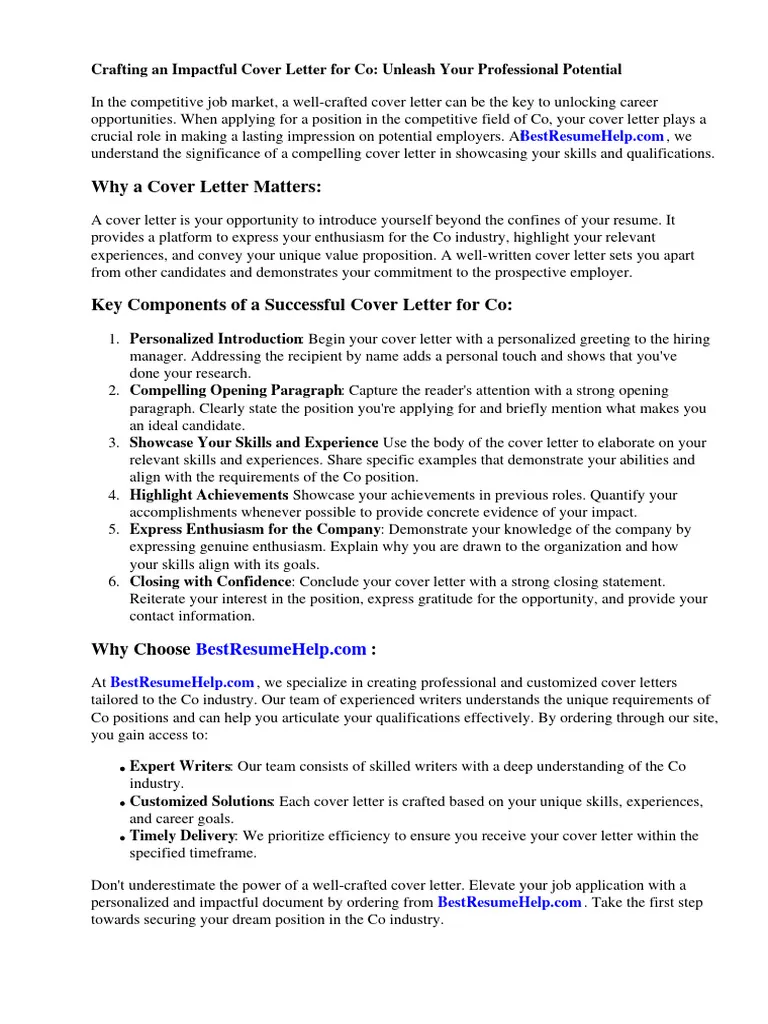
Communication jobs demand excellent communication skills. Your cover letter is a prime opportunity to show off your abilities. Use clear, concise language. Craft sentences that are easy to understand and flow well. Demonstrate your ability to adapt your communication style to different audiences. Do you have experience writing press releases, internal memos, or social media posts? Mention it. Highlight your proficiency in various communication channels and platforms. Are you skilled with content management systems (CMS) or social media management tools? Showcase your abilities by giving specific examples. Describe how you’ve used these tools to achieve results. Mention any training, certifications, or experience related to communication skills. This can significantly improve your application. Show the hiring manager that you don’t just know how to communicate; you can do it effectively in various contexts.
Demonstrating Writing Proficiency
Excellent writing skills are essential in the communication field. Your cover letter provides a chance to shine. Pay close attention to grammar, spelling, and punctuation. Proofread carefully for any errors that could undermine your credibility. Beyond correctness, strive for clarity and conciseness. Use strong verbs and active voice to convey your message effectively. Showcase your writing skills by including writing samples, such as links to your blog posts or published articles. Did you write newsletters, reports, or marketing copy? Share those details. Tailor your writing to the tone and style appropriate for the target company and the specific job. A well-written cover letter clearly demonstrates your ability to communicate effectively in writing, which is a key requirement for any communication role. (Image: writing-skills-cover-letter)
Emphasizing Interpersonal Skills
Communication is about more than just crafting messages. It’s about building relationships and connecting with people. Interpersonal skills are crucial in many communication jobs. Highlight skills like active listening, empathy, and teamwork. Illustrate how you’ve successfully collaborated with others, mediated conflicts, or built strong relationships with stakeholders. In communication, you’re often working with teams and interacting with diverse individuals. Employers want to see that you work well with others. Did you successfully manage a crisis communication situation by fostering trust and transparency? Were you part of a team that improved internal communication and employee satisfaction? These experiences provide insight into your people skills.
Quantifying Achievements and Results
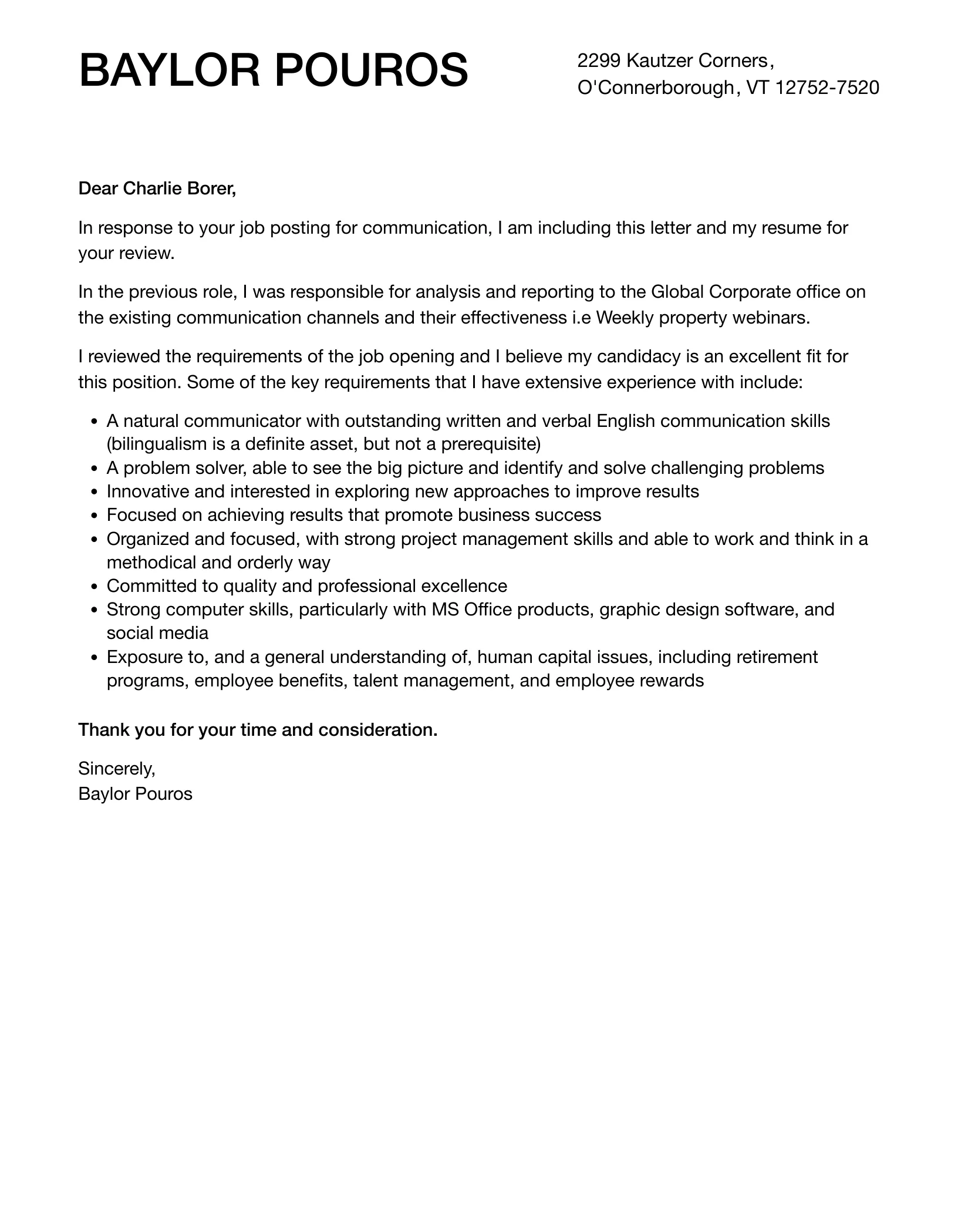
To stand out, quantify your accomplishments. Use data and numbers to demonstrate the impact of your work. Instead of stating “Improved social media engagement,” state “Increased social media engagement by 40% in six months by implementing a targeted content strategy.” If you streamlined a communication process that saved the company time or resources, include those figures. Did you successfully launch a new product? How much did it increase sales? Quantifiable results add credibility and show the tangible value you bring to the role. Use metrics like website traffic, media mentions, social media followers, email open rates, and conversion rates. By backing up your claims with data, you’ll make your cover letter more compelling and memorable. (Image: cover-letter-achievements)
Tailoring Your Cover Letter to the Job Description
A generic cover letter simply won’t cut it. Each cover letter should be customized to the specific job and company. Begin by reading the job description carefully. Identify the key requirements and then align your skills and experience with those needs. Use keywords from the job description throughout your cover letter. This will help the hiring manager quickly see that you’re a strong match. Show a genuine interest in the company and the specific role. Why are you interested in this job and this company? Research the company’s mission, values, and recent projects. Demonstrate how your skills and experience relate to their goals and how you can contribute. This level of personalization demonstrates that you have a serious interest in the opportunity.
Researching the Company and Addressing the Hiring Manager
Do your homework. Research the company you’re applying to. Understand their mission, values, and recent initiatives to personalize your cover letter. Visit their website, read news articles, and explore their social media. If possible, find the name of the hiring manager and address your cover letter directly to them. This shows initiative and attention to detail. If you can’t find a specific name, use a professional greeting like “Dear Hiring Manager.” Mention specific aspects of the company that resonate with you and explain why you are excited about the opportunity. This will demonstrate your genuine interest. Your research should inform how you discuss your skills and experience, aligning them with the company’s needs and values. (Image: tailoring-cover-letter)
Structuring Your Cover Letter for Maximum Impact
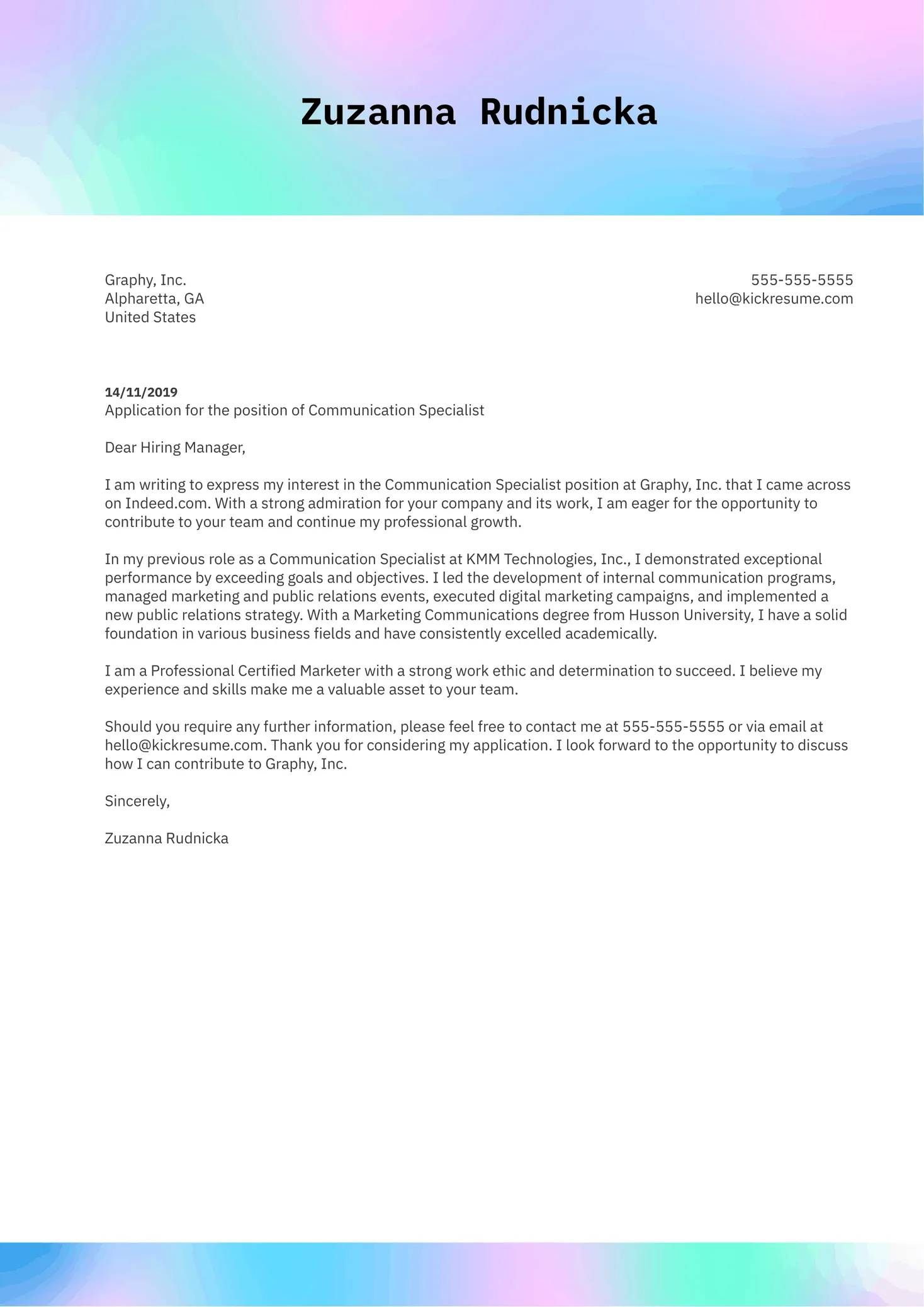
The structure of your cover letter significantly influences its effectiveness. A well-structured cover letter is easy to read and highlights your key qualifications. Use a professional font like Arial or Calibri, and maintain consistent spacing and margins. Start with your contact information, the date, and the recipient’s information. The body should be concise and well-organized. Break it down into clear paragraphs, each focusing on a specific point. Use headings or bullet points to break up large blocks of text. Aim for about one page. The flow should be logical, with a strong opening statement, a discussion of your skills and experience, and a strong closing statement. A well-structured letter makes it easy for the hiring manager to find what they need, helping you make the best possible impression. (Image: cover-letter-formatting)
Opening and Closing Statements
Your opening statement is your first opportunity to capture the reader’s attention. Start with a strong hook that immediately grabs their interest. Briefly state the position you are applying for and why you are an excellent fit. Make your opening statement engaging and convey your enthusiasm. Your closing statement should reiterate your interest in the position and express your confidence in your abilities. Thank the hiring manager for their time and consideration. Include a call to action. “I look forward to discussing my qualifications further in an interview.” A memorable opening and closing will frame your cover letter positively and leave a lasting impression.
Formatting and Proofreading for Professionalism
Presentation is critical. Ensure your cover letter is formatted professionally. Use a standard font and a font size between 10 and 12 points. Maintain consistent spacing and margins. Use clear headings and bullet points. Proofread your cover letter meticulously for grammar and spelling errors. Errors can undermine your credibility. Read your cover letter aloud to catch any awkward phrasing. A polished, error-free cover letter demonstrates your attention to detail and commitment to excellence. A professional cover letter shows you care about quality. (Image: professional-cover-letter)
Common Mistakes to Avoid

Avoiding common pitfalls is crucial for cover letter success. Being aware of these common mistakes will help you create a cover letter that shines and secures you the interview. Let’s examine some of the most significant areas to avoid. The more you understand these errors, the better your chances of success will be.
Generic Language
Avoid generic phrases that don’t reflect your individual skills and experience. Avoid phrases that could apply to any job. Instead, personalize your cover letter to showcase your unique abilities. Avoid generic phrases without concrete examples. Instead of stating, “I am a team player,” give an example of a team project you contributed to. Focus on specific achievements. The goal is to make your letter stand out from the crowd and show that you’ve considered the job’s specific requirements.
Typos and Grammatical Errors
Typos and grammatical errors are a major problem. Your cover letter must be a polished document that reflects your attention to detail and communication abilities. Proofread your letter multiple times. Use a grammar checker, and read it aloud. Have a friend or colleague review it. The effort to ensure your cover letter is error-free is important, and this attention will be clear to the hiring manager. (Image: communication-job-cover-letter-mistakes)
Failing to Tailor the Letter
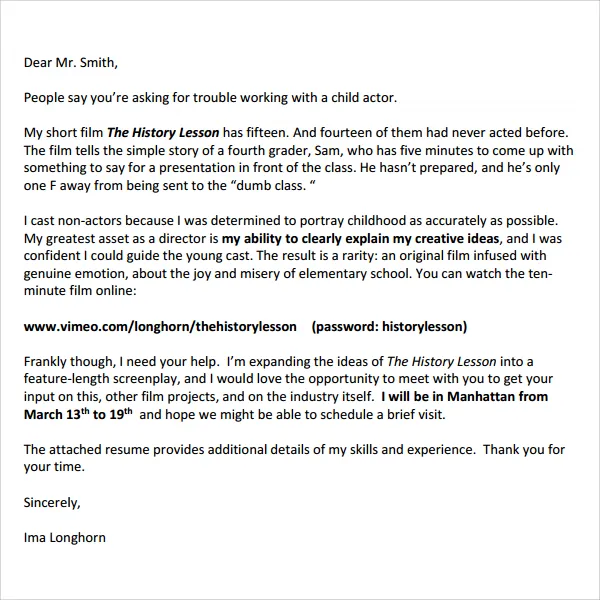
Sending the same cover letter to multiple employers is ineffective. Tailor each cover letter to the specific job and company. Research the company, understand the role’s requirements, and highlight the relevant skills. Show genuine interest in the company’s mission. A customized cover letter will improve your chances of getting noticed. It shows that you’re interested and understand the company’s needs.
Dos and Don’ts of Communication Job Cover Letters
Success with your cover letter depends on balancing your strengths and tailoring your message to the employer’s needs. Following these guidelines will help you write a cover letter that highlights your skills and increases your odds of landing an interview. Knowing what to do and what to avoid is crucial for an effective job application.
Do Emphasize Your Passion for Communication
Let your passion for communication shine through. Explain why you’re enthusiastic about the field. This enthusiasm will make your cover letter more engaging and memorable. It will demonstrate to the hiring manager that you love the role and the industry. Mentioning specific projects or areas of communication that interest you adds even more impact.
Do Highlight Your Relevant Skills
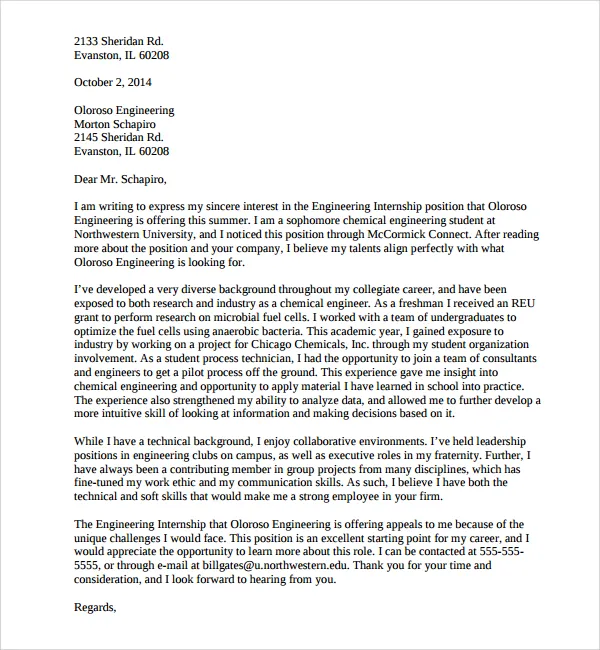
Focus on the skills most relevant to the job description. Tailor your cover letter to the specific requirements of the role. Provide concrete examples of how you’ve used your skills to achieve results. This helps the hiring manager quickly see how you can contribute to their team. Concentrate on key skills like writing, interpersonal skills, and project management.
Do Tailor Your Letter to Each Job
Don’t use generic cover letters. Always customize your cover letter for each application. Research the company and highlight relevant skills and experiences. This demonstrates that you are serious about the opportunity and have taken the time to understand the company and the role. This will set your application apart.
Don’t Use Generic Templates
Avoid using generic templates that do not reflect your unique experience and skills. Hiring managers can easily spot these, and your application will seem uninspired. Create a unique narrative that sets you apart.
Don’t Exaggerate Your Skills
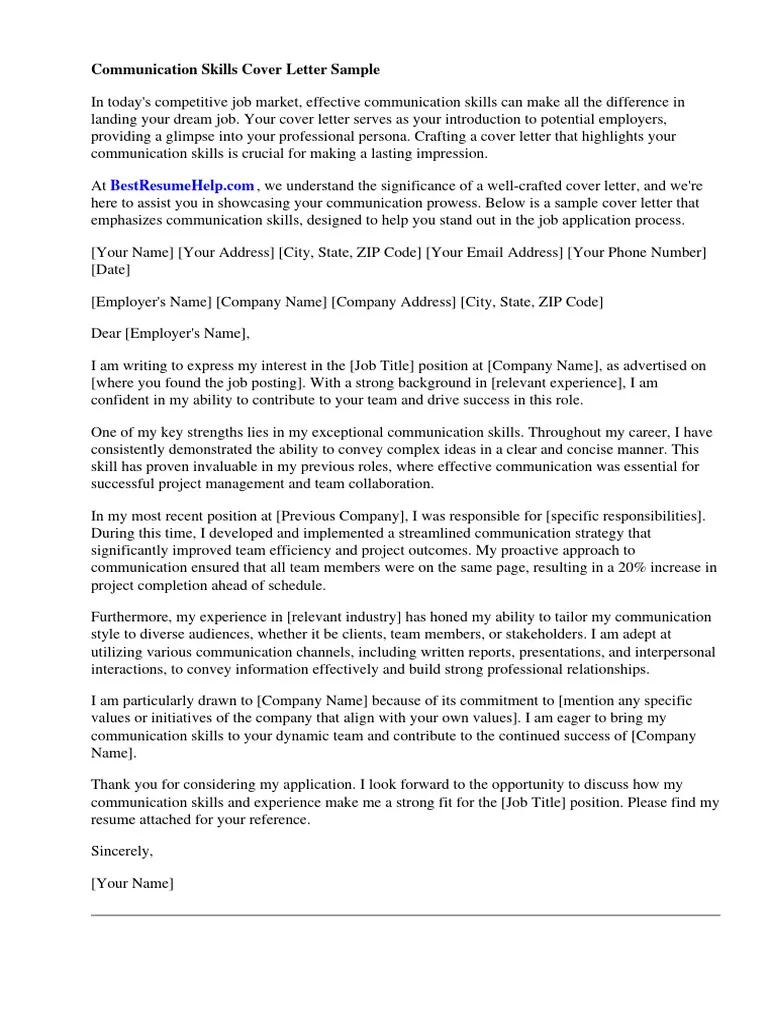
Be honest and accurate about your skills and experience. Exaggerating can damage your credibility. Always provide factual information that you can support with evidence. Focus on your strengths and experiences while remaining honest about your abilities.
Don’t Forget to Proofread
Proofread your cover letter multiple times for any errors. Typos, grammatical errors, and spelling mistakes can damage your credibility. A polished cover letter shows that you’re detail-oriented and committed to excellence. Ask someone else to review it.
Examples of Effective Communication Job Cover Letters
Learning from successful examples is a great way to learn to craft a compelling cover letter. By studying these examples, you can understand effective writing, structure, and content. Analyze the language, tone, and examples used to highlight the candidate’s skills and experience. Here are a few examples for inspiration. (Image: effective-cover-letter-example)
Example 1
This example features a candidate for a Public Relations Specialist position. The cover letter highlights the candidate’s experience in media relations, writing press releases, and executing successful PR campaigns. The candidate offers measurable results such as increased media coverage. The tone is professional and enthusiastic, and the letter is tailored to the company’s needs.
Example 2
This example features a candidate applying for a Social Media Manager position. The cover letter highlights their experience in content creation, managing social media platforms, and analyzing metrics. The candidate also demonstrates an ability to increase follower engagement. This letter is tailored to the company’s brand, and the candidate’s genuine interest is evident.
Example 3
This example demonstrates a candidate applying for a Content Writer position. The cover letter highlights the candidate’s experience in writing blog posts, articles, and website content. It emphasizes the candidate’s ability to adapt to different writing styles. The candidate provides links to writing samples, showing relevant experience. The tone is professional and focused on what the candidate can offer to the company.
